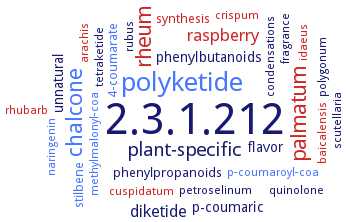2.3.1.212: benzalacetone synthase
This is an abbreviated version!
For detailed information about benzalacetone synthase, go to the full flat file.

Word Map on EC 2.3.1.212 
-
2.3.1.212
-
polyketide
-
chalcone
-
palmatum
-
rheum
-
plant-specific
-
raspberry
-
diketide
-
phenylbutanoids
-
flavor
-
unnatural
-
p-coumaric
-
4-coumarate
-
synthesis
-
stilbene
-
phenylpropanoids
-
crispum
-
idaeus
-
methylmalonyl-coa
-
cuspidatum
-
condensations
-
naringenin
-
arachis
-
polygonum
-
petroselinum
-
baicalensis
-
fragrance
-
rhubarb
-
scutellaria
-
tetraketide
-
quinolone
-
rubus
-
p-coumaroyl-coa
- 2.3.1.212
- polyketide
- chalcone
- palmatum
- rheum
-
plant-specific
- raspberry
-
diketide
-
phenylbutanoids
-
flavor
-
unnatural
-
p-coumaric
- 4-coumarate
- synthesis
- stilbene
-
phenylpropanoids
- crispum
- idaeus
- methylmalonyl-coa
- cuspidatum
-
condensations
- naringenin
- arachis
-
polygonum
-
petroselinum
- baicalensis
-
fragrance
- rhubarb
-
scutellaria
-
tetraketide
-
quinolone
-
rubus
- p-coumaroyl-coa
Reaction
Synonyms
bAS, HsPKS3, PKS1, RinPKS1, RiPKS4, RpBAS
ECTree
Advanced search results
Engineering
Engineering on EC 2.3.1.212 - benzalacetone synthase
Please wait a moment until all data is loaded. This message will disappear when all data is loaded.
C197G
site-directed mutagenesis, the mutant shows an unaltered product pattern compared to the wild-type enzyme
C197T
site-directed mutagenesis, the mutant shows an unaltered product pattern compared to the wild-type enzyme
G256L
site-directed mutagenesis, the mutant shows 50% reduced activity but an unaltered product pattern compared to the wild-type enzyme
I214L/L215F
L132A
site-directed mutagenesis, the substitution expands the product chain length to produce 4-coumaroyltriacetic acid lactone after three condensations with malonyl-CoA, but without the formation of the aromatic ring system
L132C
site-directed mutagenesis, the substitution expands the product chain length to produce 4-coumaroyltriacetic acid lactone after three condensations with malonyl-CoA, but without the formation of the aromatic ring system
L132F
site-directed mutagenesis, replacement of Leu132 with bulky aromatic residues, Phe, Tyr and Trp, causes a 1.2fold increase in the benzalacetone-forming activity at pH 8.0, whereas the bisnoryangonin-forming activity is retained or significantly decreased at pH 6.5
L132G
site-directed mutagenesis, no altered activity compared to the wild-type enzyme
L132P
site-directed mutagenesis, the L132P mutant exhibits drastically decreased benzalacetone- and bisnoryangonin-forming activities
L132S
site-directed mutagenesis, the substitution expands the product chain length to produce 4-coumaroyltriacetic acid lactone after three condensations with malonyl-CoA, but without the formation of the aromatic ring system
L132T
site-directed mutagenesis, the chalcone-forming L132T mutant shows broad substrate specificity. It accepts benzoyl-CoA as the starter substrate to produce a trace amount of 2,4,6-trihydroxybenzophenone, after condensations of benzoyl-CoA with three molecules of malonyl-CoA, along with benzoate-primed triketide and tetraketide pyrones as major products
L132T/I214L/L215F
site-directed mutagenesis, the triple mutation does not improve the chalcone-forming activity, but instead results in a significant loss of activity
L132W
site-directed mutagenesis, replacement of Leu132 with bulky aromatic residues, Phe, Tyr and Trp, blocks the entrance of the coumaroyl binding pocket and causes a 1.2fold increase in the benzalacetone-forming activity at pH 8.0, whereas the bisnoryangonin-forming activity is retained or significantly decreased at pH 6.5
L132Y
site-directed mutagenesis, replacement of Leu132 with bulky aromatic residues, Phe, Tyr and Trp, causes a 1.2fold increase in the benzalacetone-forming activity at pH 8.0, whereas the bisnoryangonin-forming activity is retained or significantly decreased at pH 6.5
S338V
site-directed mutagenesis, the mutant shows 2fold increased activity but an unaltered product pattern compared to the wild-type enzyme
additional information
site-directed mutagenesis, the mutant restores chalcone-forming activity
I214L/L215F
site-directed mutagenesis, the mutation restores the active site residues of chalcone synthase, the mutant shows chalcone-forming activity, EC 2.3.1.74. The mutant enzyme thus exhibits 36fold decreases in kcat/Km for 4-coumaroyl-CoA and 20fold decreases in kcat/Km for malonyl-CoA compared with wild-type BAS, kinetics of chalcone naringenin-forming activity at pH 6.5, overview
formation of other products such as a tetraketide pyrone 4-coumaroyltriacetic acid lactone or naringenin chalcone is not detected for all the mutant enzymes
additional information
-
formation of other products such as a tetraketide pyrone 4-coumaroyltriacetic acid lactone or naringenin chalcone is not detected for all the mutant enzymes
additional information
the single amino acid substitution L132T restores the chalcone-forming activity of chalcone synthase, EC 2.3.1.74, in BAS, probably due to restoration of the coumaroyl binding pocket in the active-site cavity, whereas the Ala, Ser, and Cys substitutions expand the product chain length to produce 4-coumaroyltriacetic acid lactone after three condensations with malonyl-CoA, but without the formation of the aromatic ring system
additional information
-
the single amino acid substitution L132T restores the chalcone-forming activity of chalcone synthase, EC 2.3.1.74, in BAS, probably due to restoration of the coumaroyl binding pocket in the active-site cavity, whereas the Ala, Ser, and Cys substitutions expand the product chain length to produce 4-coumaroyltriacetic acid lactone after three condensations with malonyl-CoA, but without the formation of the aromatic ring system


 results (
results ( results (
results ( top
top






